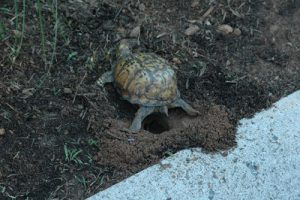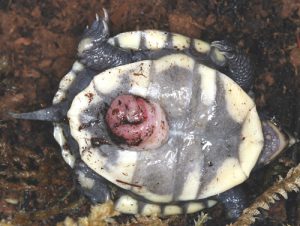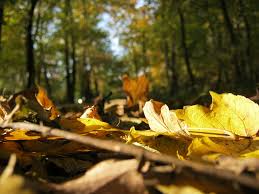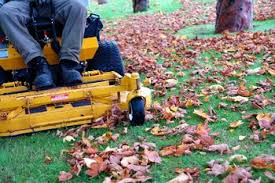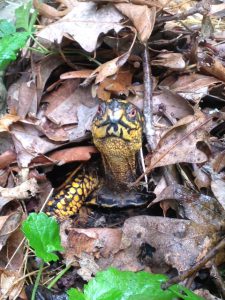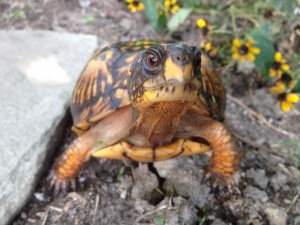|
Tag Archives: box turtle
Box Turtles and Rehabilitation
Box Turtles and Rehabilitation
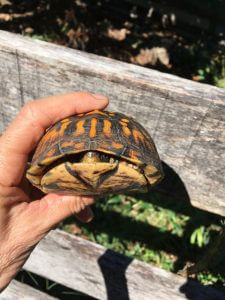
This Shell, that has provided the Box Turtle protection for millions of years, is no match for vehicles .
The unique defense mechanism of the Eastern Box Turtle has allowed for this small unambiguous reptile to survive on this planet for millions of years. It is the only animal that responds to danger by quickly and quietly closing up its shell, to form a tight box. Here in his home, this ancient reptile is well suited to wait until the danger has passed.
Our powered and developed landscape is no place for such a small dinosaur as he now finds himself closing his shell in the middle of busy streets, on mowed lawns, in crop fields, logging roads, shopping centers and golf courses. There is so little land in Central Virginia that is not logged, farmed or developed, that generations of genetic diversity have been silently wiped out. To make matters even more interesting, the Box turtles ability to survive extensive damage and to heal itself is close to miraculous.
Wildlife rehabilitators work with Veterinarians to provides medical care to injured, sick, or orphaned wildlife. Their goal is to treat the animal by providing suitable diet and nutrition, and safe and sanitary shelter, while it recovers, with the goal to return it to its native habitat:
Wild animals that sustain injuries or illnesses preventing them from living successfully in the wild usually are euthanized (have their suffering ended in a humane fashion). Occasionally, individual animals that have recovered from their injuries but are not able to survive in the wild are placed in educational facilities.” (from National Wildlife Rehabilators website)
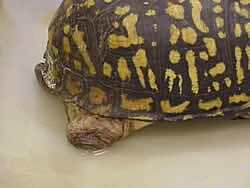
A three legged turtle often cannot contribute to future generations. Missing limbs make mating difficult and nest digging nearly impossible.
When Box turtles are found injured, and taken to a licensed wildlife veterinarian, and then supported by a rehabber, they are required to be returned to the exact place where they were found. Normally this is a good practice, as box turtles learn their habitat as they grow and will try to return to it if they are removed from it. Unfortunately often times this habitat is already compromised, which likely contributed to the injury.
Being a wildlife rehabber is a full time, unpaid, volunteer position, and most are not in a situation to be able to keep any of the animals that they tend to. Having to euthanize any animal is difficult, and it is often a thin line that must be drawn. You will find rehabbers releasing turtles that have handicaps (3 legs) or broken and missing pieces of their, shells making them vulnerable to predators. According to Virginia State Laws the only other option is euthanasia.
As the Box Turtle is not a game species in Virginia, it is silently disappearing through-out the state. Small and insignificant, there are few studies done within the commonwealth. Land held by the state is often used for other purposes, including logging, which leaves only private property as a last retreat for these ancient reptiles.
How Many Become Road Kill?
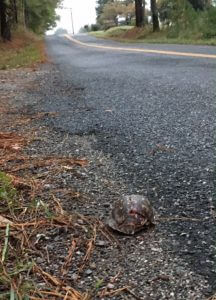
When finding a damaged turtle, it is important to put it in a dark, quiet place until help can be arranged.
Although it would be difficult to count the total number of turtles that become road kill every year in the United States, James Gibbs, a conservation biologist at the State University of New York in Syracuse decided to make an educated estimate. He took into consideration three factors: traffic density, the speed with which turtles cross the road and the number of roads in the US.
Gibbs estimate shows that turtle populations in the Northeast, Southeast and the Great lakes region suffer from a 10 to 20 percent mortality rate due to traffic encounters, high enough to deplete turtle populations. The Animal Protection Institute in Sacramento, California, places road kill mortality between one half and one million animals daily.
In Central Virginia alone 99% of injured turtles that make it to a wildlife veterinarian are suffering from a collision with a motorized vehicle. The remaining 1% is damage done by domestic canines.
Sanctuary or Death?
Turtles and encounters with motorized vehicles, is not a turtle problem, but a human consequence.
Here at the Box Turtle Sanctuary, our current focus is on education. We are not a rehabb facility, as the time commitment, both to become licensed and of the maintenance of in house rehabbs would not allow me to pursue the goal of the sanctuary which is to provide permanent safe shelter through natural, native habitat for misplaced eastern box turtles, due to habitat loss or that have been pets and are unable to be released into the wild. This includes animals that were damaged due to human encroachment, treated at wildlife vets, rehabbed and unable to be returned to the wild due to handicaps.
This being said, I am more then happy to educate turtle owners on how to achieve better environments and habitats for their pet turtles and I will continue to advocate for any turtle in need to make sure it gets the help that is necessary for its health.
Humans are responsible for this extreme loss of habitat, and as stewards of this earth and this land, it is our responsibility to provide habitat for all creatures that were residents before us.
So where do we go from here?
I am amazed at how Central Virginia continues to promote urban sprawl. Our residents and their children are becoming more and more removed from our natural world. We are at a critical time in our evolution, where humans are poised to create the next great extinction event.
Education is only the tip of the spear. Providing a safe sanctuary for these misplaced turtles, also provides an educational opportunity for study, exploration and a connection to the earth that we once shared .
Turtles are ancient, they are survivors, and they are part of our Earth.
PLEASE leave your comments

HELP ! I Found A Baby Turtle!
Baby Turtles ARE Amazing
Finding such a small creature is indeed a stroke of chance and luck, but is it right to think that it needs help and that you should take it home?
Before you decide that this little dinosaur will be better off with you lets consider some facts and the circumstances.
EVERYTHING and I mean everything a turtle does is due to its connection with the earth and the weather in its habitat. Turtles have been surviving this way for more than 200 million years, yes, since the days of dinosaurs, and have evolved to have some amazing “super powers” to get them through the tough times. All turtles come from eggs, and like the Dinosaurs before them, incubation lasts for at least 60 days. In climates where turtles Brumate(Hibernate), it is not uncommon for hatchlings to stay in their underground nest for their first winter and wait for spring rains to awaken them for their first venture to the surface
of the earth.
All mother turtles will prepare a nest by digging a hole with her back legs as deep as she can. Depending on the weather and food supply, some turtles will lay a clutch of eggs two or even three times a summer, and
although mother turtles abandon their nest after it is completed, each type of turtle will carefully find the best location to dig their nest and, to give their hatchlings the best chance of survival. Most turtles, including water turtles will seek out land that is above flood level to place their nest, allowing temperatures in the nest to stay stable.
Why did you find a Baby Turtle?
Fluctuating temperatures are the most common reason that one finds baby turtles during times of the year when you would not expect to find them. Late warm rains in October, or early warm rains in March sometimes trigger the “its spring” response in nestlings causing them to dig to the surface, only to find an inhospitable climate.
Baby Turtles are also often disturbed with construction. Finding baby turtles in newly dug piles of dirt from previously undisturbed wooded areas is becoming more and more common as we push the limits of preserved land, and encroach upon native habitat.
What Kind of Turtle Did You Find?
To the common eye, baby turtles all look alike, but can be easily differentiated by carefully looking at their feet.
Box turtles are land turtles and have small dinosaur like feet. It is very important to note that Box Turtles are NOT water turtles, and although they can swim, they will also drown if unable to get themselves out of the water.
Baby Water turtles like sliders, paints and cooters, have little webbed feet, and surprisingly the nests are often a good distance to the fresh water where their parents live.
Baby Snappers are also often found away from water and are distinguishable by their prehistoric
looking shell and extremely long tail.
Ocean turtles have flippers, are found on the beach and should NEVER be taken home. They are endangered and protected and It is nearly impossible to raise them in captivity. If you find one, you can help it get to the ocean, if it is injured, contact the local authorities for more directions.
Here are the things that all baby turtles have in common:
- Baby Turtles rely on their dull coloration for camouflage.
- Baby Turtles have no protection other than hiding.
- All predators find baby turtles to be a nice snack. It is believed only one in 1,000 will survive to reproductive age.
- Baby Turtles are prone to dehydration.
- Baby Turtles hatch with a “Yolk” and will / can survive 7-10 days once hatched with out food.
- Studies have shown that baby turtles are not born with the homing instinct that their parents have, but acquire it over time. (exception: ocean turtles)
What To Do With Your New Find?
This is where it gets tricky.
Due to habitat loss and destruction, it is not uncommon for mother turtles to locate their nests in places that are less then ideal. One recently more common place is along road ways where the earth is well packed, and with a “stream” (ditch) along side. Not an ideal place for baby turtles of any kind, and with the lack of habitat in areas that are well established by humans, baby turtles show up in the most unlikely places.
Baby Turtles are great to visit with, take some photos and show your kids, but unless we can let these turtles remain in the wild, they will soon be extinct in areas that they called home for millions of years.
That being said, to release a baby turtle in suburbia and expect it to survive to adult hood is far-fetched indeed.
Baby Turtles need shelter. They need food and water. If the seasons are appropriate your little turtle should be taken to an area that will supply him with what he needs to survive and grow and be released. If it is late fall through early spring, you should contact a local wildlife rehabber or a wildlife veterinarian that can give you names of qualified people that can help direct you.
Turtles as pets are a Hugh responsibility. Turtles can live 50-100 years and require a habitat that simulates as close as possible the habitat that they would have in the wild, including natural sunshine, and a varied diet.
The two baby box turtles that were brought to me this winter with severe dehydration, perished shortly after their arrival. Both of them were initially kept by well meaning people that wanted to share them with their children. I was contacted once the adults realized the turtles were fading. If these two little ones had been released / relocated when found, it is possible they would be alive today. 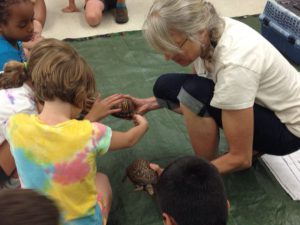
The best way to help turtles is to educate!
I offer educational programs for groups of any age and am currently accepting dates for Summer 2017. My programs include hands on Adult box turtles, along with water turtles and babies.
I am happy to help our shelled friends in any way I can. If you have questions, Please leave me a message.
Turtles all the way down!
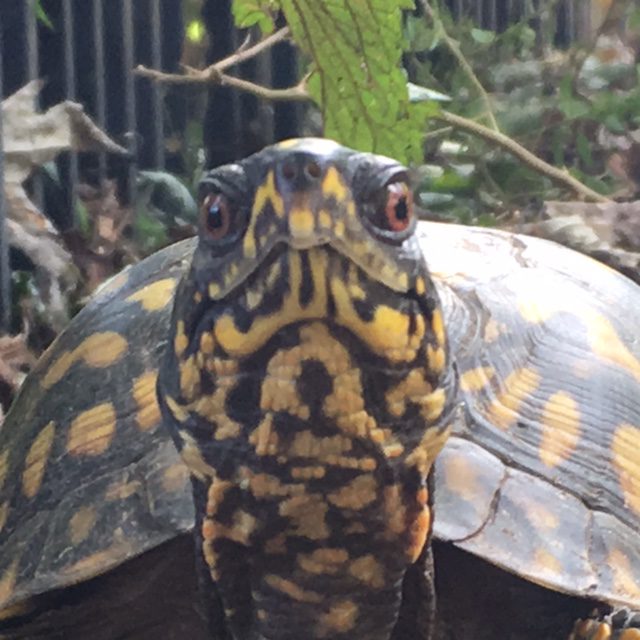
You’ve Adopted a Box Turtle, Now What?
Congratulations!
Box turtles are one of the oldest animals on our planet, and certainly one of the most unique and personable critters one can know.
I like to think of Box Turtles as having Super Powers. They evolved with our planet since the days of the Dinosaurs! Turtles have been here, on earth, for more then 200 million years. Think about that. That is a lot longer then humans have been around. Turtles were able to survive mass extinctions that wiped out most of the inhabitants on this planet, more than once!
How Did they do That?
Turtles are so connected to our earth and its temperature changes, perhaps this is one of the super powers that allowed reptiles to survive extinctions, the ability to dig in and wait out the in-hospitable climate of thousands of years ago.
Being reptiles, Box turtles are unique in that they are ectothermic. That means along with fish and amphibians, they are cold blooded, and cannot regulate their own body temperature. Reptiles body temperature fluctuates according to its surroundings.
Mother Nature has been taking care of our shelled friends for a very long time, and, well, turtles know how to be turtles. It is very difficult to replicate the exact conditions that mother nature has provided them all these years. Keeping your turtle inside, whether it be year round or just for the winter can be done, but it does take some research, some practice and quite a bit of supplies to do it right.
How hard is it to keep a box turtle as a pet?
Although Box turtles seem slow and unassuming, it is important to remember that they evolved to be perfectly suited to live in their specific habitat, and although it may seem that they would be an easy pet, That is indeed a false assumption.

Leaves help retain moisture, decompose by feeding worms and bugs, allow for natural foraging and create a natural floor for the eastern box turtle
Even if you keep your Box turtle in an enclosed pen outside, it is not the same as being wild. In the wild they have a territory that can span the space of 10 football fields, and being an opportunist, will eat almost anything organic, including dead things, rotten things and even poop. Certainly these are things you would not and should not feed your captive Box turtle. In the wild, box turtles are able to find a wide variety of berries, mushrooms, insects and all sort of things that we can hardly duplicate in captivity. So it is of utmost importance that your box turtle get a variety of foods including a good bit of protein. It is believed that up to 75% of a Box turtles diet in the wild consists of insects and protein sources, which allow calcium for growth of the all important shell. Captive Turtles kept outside or inside should be fed and monitored daily during the summer months. Many Box turtles enjoy soaking in their water bowls and often like to relieve themselves during their soak, making daily water cleaning a necessity and important for the health of your turtle. Summer feeding is also an important time for Box Turtles to store fat for winter hibernation.
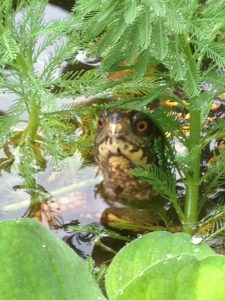
Box turtles enjoy a occasional soak, and often relieve themselves in the water.
Your outside turtle habitat will also need protection from unwanted guests and predators. In the wild, just about any predator will eat a small box turtle. Besides the normal predation of raccoons, skunks and the like, Crows can be especially dangerous if your habitat does not have enough plants to provide shelter. Even ants and mice can do damage to sleeping turtles. Many turtle keepers keep their outdoor turtle habitats covered with some sort of wire, and year-round maintenance and surveillance is required
If you plan to keep your new Box turtle indoors, You will want to supply him with as large of a habitat as you can. He will need clean water, and a special full spectrum sun light bulb. Your Box turtle will need humidity, a natural substrate that includes earth, leaves, bark, and plants native to his natural habitat (preferably ones he can eat). He will also need a place with deep shade (a hide) and he will need an extra heat source,so he can be kept at a suitable temperature. If possible this habitat should also have some worms and grubs for natural foraging.
If your Box turtle came from a place where winter is cold, then your box turtle most likely has hibernated or Brumated, as reptile people call it. Triggered by lack of heat and the decrease in the hours of daylight, Brumation is a state of dormancy in reptiles that is similar to hibernation in mammals, but differs in the metabolic processes involved, almost a chemical process.. Reptiles can go months in this state of torpor, but occasionally wake to drink water and then return to “sleep”.
Does my turtle need to Hibernate / Brumate?
Now that you know what your turtle would do in its natural environment, it is up to you whether or not you let your shelled friend have a long winter nap. If you decide to keep a turtle as a pet it is your responsibility to provide the best possible care, whether you keep him inside or outside.
Some Turtle keepers believe that if your turtle would have hibernated / brumated in its natural
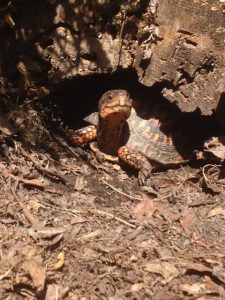
Hollow logs, cut in half make great hides year round.
habitat, they should be allowed to hibernate. Perhaps, due to the amazing ability to slow its metabolism during times of hibernation, the box turtle is able to live a good 100 years given the proper care. Still, many box turtle keepers will keep their turtles awake and inside all year, by maintaining heat, humidity, and daylight hours.
Many turtles will want to eat more before brumation time, but once the temperature drops on a regular basis, they will eat less and eventually refuse food, allowing their system to empty before their long winter nap.
There are a lot of ways to hibernate your turtle and a lot of how you go about it depends on your situation and available space. Turtle keepers are usually more than happy to give advise, and opinions, and are more then willing to help out our shelled friends.
I strongly recommend being connected with other box turtle enthusiasts on-line as soon as you decide to get a turtle. There are many turtle groups on Facebook and in turtle forums.
Be a Responsible Turtle Owner!
In the wild, Box Turtles are not in small boxes or glass containers and have a lot of room to find adequate food, shelter and sunshine. In our care we are responsible for every aspect of their needs and can’t let anything go with “In the wild” because it is NOT the same. Just because you keep your turtles in a small enclosed area outside does not mean they are wild or should be expected to survive as wild turtles do. If we decide to keep them as pets, whether indoors or out, we need to provide the best possible care that we can.
Please do your research before you venture into the responsibility of taking care of Turtles of any kind. Turtles do need our help! They are amazing and fascinating animals, and there is a lot of things we have yet to learn about them and their ability to survive. It is important that we share our love for these docile creatures with future generations, so they may survive the human race and our endless destruction of their earth.
Every turtle owner and potential owner needs to watch this short video at least once. Please watch it so you can see how important proper husbandry is for your new turtle.
The below articles were written by Sandy Barnett senior author of “Indoor Care of North American Box Turtles”. Sandy produced an educational CD on the natural history and conservation of the eastern box turtle (“Eastern Box Turtles, Disappearing Gems of the Forest”) for MATTS (Mid-Atlantic Turtle and Tortoise Society). It has been distributed to secondary schools, nature centers, and wildlife agencies with youth programs, and translated into German for distribution in German-speaking countries. Sandy also serves on the North American Box Turtle Conservation Committee. You can read more about Sandy Barnett here.

A young Eastern Box Turtle
Diet recipe ingredients and instructions
Do you have a unique or different idea that makes taking care of your box turtles more efficient? I would love to hear about your turtle adventures! Please drop me a line, or ask me a question, lets see what we can figure out!
Shelley

Got Leaves? 3 Ways to Avoid Raking Leaves
We love trees, trees provide us with shade, some trees even provide us with food, and come autumn, as trees begin to ready themselves for winter, they often put on a spectacular show of lovely warm colors.
If that sentence got you anticipating what comes next, you are not alone! Raking leaves is homeowners second least favorite yard chore, right behind cutting grass.
It is estimated by the National Wildlife Federation that more then 33 million tons of yard waste are added to US landfills each year, accounting for 13 percent of the solid waste. But the bad news doesn’t stop there.. These leaves, buried without oxygen, are responsible for creating methane (greenhouse gas) at an alarming rate in our nation’s landfills.
With more than 40 million acres of lawns in the continental US, turf grasses add up to be the single largest irrigated crop in the nation. That is at least three times as much space as irrigated corn.
Before we became obsessed with tidy yards and homeowners’ association rules, we lived in a much healthier habitat, and although a heavy layer of leaves may cause damage to your lawn grasses, there are ways you can help the environment, wildlife and your lawn with out hauling away those leaves.
Three beneficial ways to use leaves
1.) Did you know that leaves can actually impede weed growth? Research done at Michigan State University showed that when leaves are left until dry and crunchy, and then mulched with a mower into little pieces, they reduced dandilions the following spring by up to 80 percent. The added nutritional boost also produces a significant spring greening effect on the turf.
Leaves are our earth’s food. They are an incredible free resource that begins the food chain in our back yard.
While still on the tree, leaves provide homes for animals like squirrels and birds and when they fall to the ground, organisms that live on and in the soil slowly consume them creating the rich soil we find in our native forests. Mulching these leaves back into your lawn helps maintain the natural balance, and reduces the amount of fertilizers and chemicals needed to keep it healthy.
3) Leaves are an affordable easy garden bed mulch. For finer texture mulch you can mulch them first. (Don’t have a mulcher? Place some leaves in a trash can and use a weed eater to mulch them). You can place leaves around your trees, shrubs, and perennials, and you can place them over exposed roots. Leaves are a advantageous winter garden cover, will help reduce the number of weeds, and can be mixed in with the soil come planting time.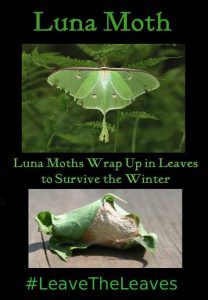
You can create compost by combining fallen leaves, grass clippings and other green material. Keeping your compost moist and well mixed will provide you with a nutrient dense mix for your spring garden. You can also share the leaves with your neighbor or a community center
Need more ideas for your leaves? Check out National Wildlife Federations site at www.nwf.org/gard.
Do you have a good use for leaves? I use a lot of leaves for my Box turtles.. keeps them cool in the summer and well insulated in the winter.. What is your favorite use?
Rappahanock Electric Co-op Destroys Native Habitat
Habitat Destroyed?
For me, there is no worse sound in the world then the “BEEP, BEEP, BEEP’ of heavy equipment. It means that something is getting destroyed, and it is usually habitat. Today, as I headed out to do my morning chores on the farm, I noticed a Rappahanock Electric Co-op truck and a good sized tractor, complete with protective cage, and bush-hog, heading down the dirt road that skirts our property and leads to the power line right of way that follows the back property line of our 20 acres. It wasn’t long before I saw the Pick up leave and heard the tell tale; Beep, Beep, Beep… of the tractor
and knew I needed to investigate.
Now don’t get me wrong, I love being part of the Co-op that Rappahannock represents. They are quick to respond to issues and generally much more consistent then their counterparts. REC also publishes an adorable monthly magazine that keeps members in the know, shares members photos, and has a lovely calendar of events from far reaches of the state of Virginia. Earlier that morning as I enjoyed my first cup of coffee I mulled over the monthly issue that had arrived just a day before with a very nice article about the monarch butterfly and how we can help them by planting milkweed. So I jumped on the RTV and followed the path that the tractor had taken down the dirt road.
A Very Wet Spring!
This spring has been and interesting one with more rainy days then sunny ones and we are currently at more then double the normal amount of rain. The back of our property, where the power line runs, also is bordered by a small creek that flows year round and judging by the deep crevasse it has made, has done so for many, many years. Unless you are a deer, one cannot walk the length of the property due to the steepness of the banks, and the briers, ideal habitat for small critters, including snakes and turtles. Besides providing berries, seeds, flowers and foliage for the wildlife to enjoy, many of the plants also provide year round shelter and protection, and help discourage trespassing hunters from using it as a cut-through. The trees that border the REC right of way have been pruned on a regular basis and the saplings that grow here and there are best cut by hand in such a treacherous area. It just so happens to be raining… Again..! The plants that hold the earth together in the back of my little piece of paradise have been cut to the base and the surviving mud is trench thick. I am amazed that the tractor is still upright, and as the gentlemen that watches me approach waves down the driver of the tractor, my heart sinks when I see the condition of my blackberry patch that was in full bloom.
Blackberries, brambles, sticker-bushes, call them what you will, but they are a mid summer staple for the box turtles that call the sanctuary home. Once they are ripe, the birds, deer, turtles and myself all vie for a good location to reach as many as we can. The Milkweed and the poke-berries, weeds to some, to me important natural food for the native animals that have lived here before our people knew this country. They are all gone now..
My conversation with the “powers that be” following the destruction of the native forage along the right of way has left me amazed, confused, disappointed and totally frightened for the future of our earth. There will be a day when we will all be accountable for the damage that we have done to our planet. Rappahanock Electric Cooperative evidently does not practice what they preach. REC has a excellent opportunity to improve the areas that they must traverse, to be proactive by communicating with land owners, educating them about wildlife habitats, planting native perennials, and encouraging the community to participate in efforts to give wildlife a place to live. The apology that was offered was shallow and meaningless. Unless this is acknowledged with-in the higher authority, through planning and education, I am afraid we are doomed.
I am a member of this cooperative, and I will let my thought on this matter be heard.. People, we need to start somewhere.. Please start in your own yards. Please be proactive in the protection that you can provide for any of our native animals, and plants. Stand up for our planet! For goodness sake.. STOP for turtles crossing the roads! ALL LIVES MATTER! If we cannot preserve what was here before we came.. then we cannot preserve ourselves. We are all part of the circle of life on this planet, and if you see someone else disrespect our earth.. Do Something About It!
Shelley
The Eastern Box Turtle’s Spring Arrival
Eastern Box Turtles are waiting for the sun.
Some times I wonder if I am the only one that sees them. They march silently from the woods along the road.. recently awakened from a long winter sleep by the warm spring rains… slow in coming this year, but the sun is calling, daylight has increased making the sun warm enough to raise body temperatures enough for the digging to start. Hatchlings, often after staying in their nest all winter are beginning to see sunshine for the first time in their life. The Eastern Box turtle begins a new year in its unique and ancient way of life.
Last spring, as I traveled along a busy road in Western Hanover County, Virginia, I straddled a newly hatched turtle scurrying as fast as he could across the road. By the time I got turned around and back to where the turtle was, the wet spot on the roadway was indistinguishable.There was a lot of traffic that day.. Did anyone else even see the little guy? Did the person who flattened him even know what they had done? Did they care?
Watching the Roads…
Often I will see them on the back roads, drive 100 yards, while my inner dialogue tells me it wasn’t a turtle at all.. not being one to get it out of my head, ..I eventually turn back to see the leaf, pine cone or scrap of wood that I was sure was a turtle.. They will be out soon .. the temperature of the days and the rising humidity will bring them out, so be prepared.
I see less and less of them every year. as the community gets developed around me, and the traffic continues to rise, the ones that I had helped crossed the road every year have been lucky to survive. Very few of these survivors are seen now, hopefully they have found more interesting things elsewhere in their habitat of 2-10 football field size areas that are etched in our resident turtles brain. They know every water hole, every berry patch,where the best place to find worms is and where the best place to hibernate is. Like a bird flying south, the uncanny homing instincts in box turtles often puts them in great peril when they are taken away from their territory or their territory is destroyed, and they try to find it. The Eastern Box turtle needs our help now. Land in central Virginia is at a premium, and due to the extensive sprawl and ease of travel, most of the land from DC to Raleigh, NC is easily accessible and prime for development. This rare and unique land, which follows the fall line of the Eastern United States, offers a lot to its residents, both four legged and two, and
should be carefully evaluated and preserved for future generations. Humans it seems, have forgotten that these ancient reptiles are dinosaurs and their ancestors lived here 250 million years ago, and If there is one thing that turtles know how to do, it is being a turtle and surviving. But, if we continue to destroy habitat at the alarming rate that we currently do, these small relatives of the dinosaurs, will disappear totally from our planet.
The extinction of the Dinosaurs
Reptiles and Amphibians are amazing indicators of our planets health, and they are currently suffering from diseases that are thought to be caused by pollutants in their environments. Recent findings are showing that viable populations are being wiped out in the wild from viruses that are not fully understood or treatable.
Recently, I read a post from a friend that listed all the stress factors in her life. The list began with her work, followed by family, pets, and lastly her turtles, whom she commented, actually were responsible for reducing her stress, and the time she spent with them was the happiest and most peaceful of her day. I know we can’t all be turtle caretakers, but I do believe that we all should take time to appreciate the world around us, get out into the woods, notice the harmony of the trees, the rivers, the wind and the earth, and do what we can to protect and preserve this amazing planet for our grandchildren before it is too late, and PLEASE, try to notice the turtles walking along the road, trying to cross, and maybe stop and give them a hand… for these little dinosaurs have seen and survived a lot, I am sure if we take the time, there is so much to be learned from them.

Box Turtles are coming out of Hibernation
Virginia is known for its crazy unpredictable weather
Especially in the spring and fall.. seasons tend to blend together. This fall, winter, spring season certainly has been no exception. It amazes me that any of our native turtles survive these crazy changing temperatures, but hey, they have been around for more than 250 million years, so I guess our weather patterns are mild compared to some that they have endured over the centuries. Interestingly enough, the weather here in Central Virginia, is not the turtles biggest concern.
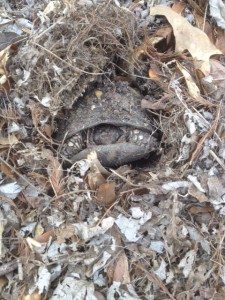 Survival of the fittest
Survival of the fittest
Turtles do what they have to do just to survive. A couple of extremely warm days and The Eastern Box turtles begin to poke up out of the dirt. There is no mass exodus from the ground, rather it is about the sun and the heat. Slowly they work their way to the surface after being buried in up to a foot of soil, eyes still shut, seeking out the warmth of the sun and hoping for a warm spring rain to rinse of the caked on mud and to re-hydrate. The middle of March is extremely early for this awakening, and turtle watchers, although excited about the reappearance of their shelled friends, worry about the inconsistent changing of the weather and the turtles ability to dig back into the earth when the weather turns cold again.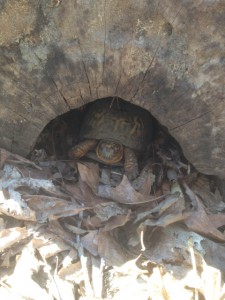 The Eastern Box turtle has many threats to its survival in this day and age, one would hope that they have a good grasp on dealing with the weather in a place where they have live for generations, but if an individual turtle goes into hibernation without being in optimum health, being caught in a cold snap can mean the ultimate demise for that turtle.
The Eastern Box turtle has many threats to its survival in this day and age, one would hope that they have a good grasp on dealing with the weather in a place where they have live for generations, but if an individual turtle goes into hibernation without being in optimum health, being caught in a cold snap can mean the ultimate demise for that turtle.
So many box turtles are relocated by good doers who find them crossing the road in places where there is no longer habitat enough for them to survive. Choices are slim, and often dictate that the best option for these turtles is to relocate them to a nearby park. Box Turtles have an uncanny instinct to return to their native hatching place as they know that territory… if this has been destroyed then survival is dependent solely on luck to find food and water. A Box Turtle can go a long time without food and many of these transient turtles can survive their first lost summer, but when winter approaches if they have not stored up the necessary reserves for hibernation, it may be their last.

Soon, Turtles will begin marching about, looking for other turtles, food and water. Remember to look out for these amazing reptiles crossing the roads, especially after a warm spring rain, in the early morning hours, and help them across if you can. With all the threats that turtles now have to their very existence, it is so very important that we leave them in the wild whenever possible. Viable populations of turtles are becoming more and more rare in their native habitat so it is up to us to try to save, create and preserve habitat where ever we can.
Have Questions on a found Box Turtle? Leave me a comment and I will get back to you ASAP.. Thanks for helping these amazing gems of the forest!
Shelley.[sgmb id=”1″ customimageurl=”” ]
LOST and FOUND
I found one of your residents yesterday. He was narrowly missed by oncoming traffic. You see, he is lost. His eyes are swollen shut, and he seems to have a cold.
I did my best to provide a good summer, lots of rain helped provide moisture for invertebrates and sunshine helped the native plants provide fruit and berries. I really try to provide all my residents the necessary habitat that will sustain them with the food, water and companionship for a long happy life.
I see you cut down his forest. I understand that my natural resources are important to you and of course they are renewable, thank you for letting me re-seed the land. But you took away important resources for many of my residents, and this one, well he was born right by that big oak where you left a stump, near the blackberry patch that you tore out because it was in your way, and he knew every inch of the 10 acres that he called home. He knew where every waterhole was, and he knew when and where to find the mulberries and blackberries, and he knew the best place to find worms and slugs. Now, his habitat is unrecognizable to him and he is lost.
This native resident is very special to me. He can only be found in the eastern part of the United States, and his descendants go back to more than 200 million years! This guys family has survived mass extinctions, and his body type has changed little over the years due to his successful survival rate. You see, he is able to hibernate and he can survive for a long time without nourishment, his body essentially shuts down. All of his organs change pace so that they are providing the most minimal output possible while still maintaining life. His heart rate, normally 40 beats a minute, slows to 1 beat for 10 minutes. He is a survivor, but now he has met his match.
Homo Sapiens now rule the east coast corridor of the United States, and as the population grows so goes the forest. You can see by the map below how little land is preserved by State and Federal programs in Virginia. And the lands that are protected are mostly difficult to negotiate and best left to the wilds. I appreciate that; as there are incredible habitats in these areas for your native creatures. However, you are missing the boat!
I am dismayed over the plight of the Elephants in Africa, the Whales deep in the ocean, and every little frog in the rainforest, and I am grateful that there are Homo sapiens that are studying, monitoring, and protecting these creatures the best they can. You must all know that I stopped making land a long time ago, and once it is destroyed, the habitats and the animals will not readily return, for they depend on the forest and the plants for their survival. Your little resident does not have the option to gallop away to another patch of woods. No… his journey would be a long arduous one, and if he did manage to cross the highway the likelihood of him being able to find food and water is slim.
Virginia, It is not too late! You need to preserve the land, the trees and the streams that support these amazing animals. Private land ownership is not the answer. Your small people parks are not the answer. Virginia, if you don’t preserve some land soon, you will have wiped out much of the genetic diversity and history that these little residents carry in their DNA.
Before all the animals disappear from the center of your lovely state, where the people live, You need to create a natural area for the wildlife. An area where your people and their grand children, can come and see the diverse flora and fauna that this state has to offer. You see, our little disappearing Gem of the Forest is The Eastern Box Turtle.
Habitat lose and destruction is only part of this little survivors struggle to endure. The Eastern Box Turtle is one of the most beautiful turtles in the world and highly sought after for pets. Poachers ship turtles for medicinal purposes and consumption all over the world, and your little box turtle is not immune from this illegal and unethical practice. There is so much that Homo Sapiens can learn from this little Turtle. Scientists have barely touched on the amazing abilities of survival that these guys posses.
Your little Resident will be okay. I have given the Box Turtles in your state an advocate, and I have sent him there. When spring arrives in your lovely state he will be released in the sanctuary with others of his kind, where he can live as a turtle for many more years and teach your children about the amazing world in which he lives and what they can do to help his nation survive.
Thanks for listening
Mother EARTh
Without ART there is no earth
https://boxturtlesanctuaryofcentralva.com



